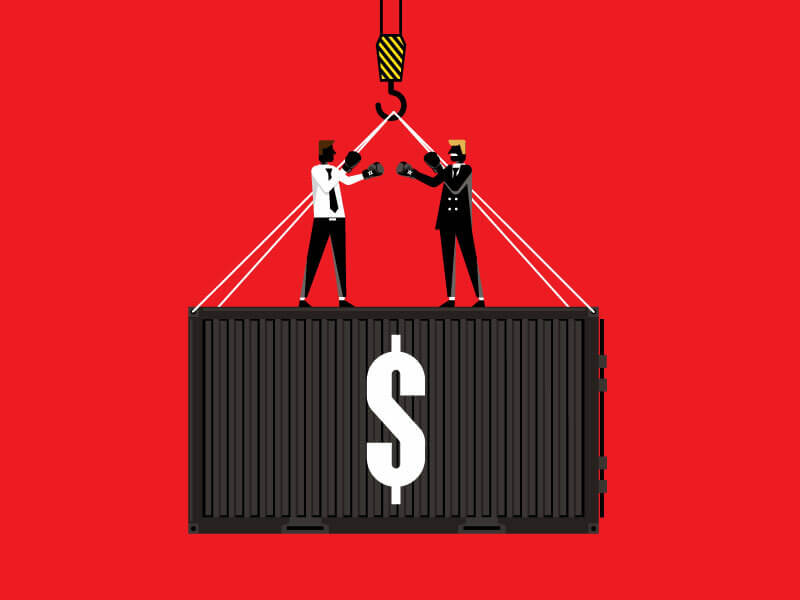
Tariffs and duty payments go hand in glove with international business, but are some better or worse than others? U.S. reciprocal tariffs are now in place, so let’s break down just how they being applied and what impacts importers can expect.
Key Takeaways:
Let’s review the details surrounding current reciprocal tariff proposals and what they may mean for the U.S. and world economies.
After months of announcements and delays, the U.S. implemented reciprocal tariffs August 7th, 2025. Some of the reciprocal tariffs are stacked on top of tariffs that were issued by the International Emergency Economic Powers Act (IEEPA).
This has resulted in rates up to 50%. Instead of listing every single nation, let’s start by taking a look at the rates affecting the U.S.’s top three trading partners.
| Country | Tariff Rate |
| Mexico | 25% |
| Canada | 35% |
| China | 30% |
Provided by The White House
Despite the tariffs on Mexico and Canada, you can still import goods duty-free from both countries if they adhere to the United States-Mexico-Canada Agreement (USMCA). Now, we’re going to cover the countries that have received the highest tariff rates.
| Country | Tariff Rate |
| Switzerland | 39% |
| Syria | 41% |
| Laos | 40% |
| Myanmar | 40% |
| Brazil | 50% |
Provided by The White House
An example of a country receiving stacked tariffs is Brazil. The reciprocal rate on this country is only 10%, but the IEEPA tariff is at 40%.
Certain commodities are subject to specific tariffs due to section 232 of the Trade Expansion Act of 1962. Steel and aluminum imports have been subject 50% rate since June 4th. The UK is the exception to this rate. Instead, steel and aluminum are only facing a 25% rate. On August 1st, a 50% rate was placed on semi-finished copper and intensive derivative products.
Foreign-made automobiles, engines, and other car parts have a 25% tariff. However, if these commodities are imported from Japan, they’ll only receive a 15% rate pending ratification of a trade deal reached in early July.

How Are Your Products Impacted by Tariff Changes? Ask Our Experts.
Our 45 Minute Licensed Expert Consulting Will Personally Guide You.
President Trump’s second term has been marked by a series of tariffs, among them the intent to use reciprocal tariffs to combat trade imbalances.
Historically, reciprocal tariffs have been used by the U.S. to that effect. Franklin Roosevelt used them in the 1930s to negotiate bilateral trade agreements in which both nations lowered tariffs.
The current proposal, the Fair and Reciprocal Plan outlined in a presidential memorandum in February 2025, is focused on raising domestic tariffs to match those imposed by other nations on U.S. exports of the same product.
An attempt at such measures was initially put forth through the U.S. Reciprocal Trade Act in 2019, though it ultimately failed to pass.
Trump’s current memorandum has also not resulted in immediate action or the application of duties. Instead, it has announced an investigation into foreign trade policies and barriers imposed by other nations against U.S. exports.
Investigations will be conducted through the U.S. Office of the Trade Representative (USTR) and the Secretary of Commerce (Commerce). Other agencies would get involved as needed, depending on the industry affected.
No investigation is to officially start until the agencies tasked with generating reports under the America First Trade Policy Memorandum are completed. Such reports were to be completed by April 1, 2025.
Related: Trump’s America First Trade Policy: What it Means for U.S. Importers in 2025 and Beyond.
While the current call to increase tariffs is the opposite of how reciprocal tariffs in the 1930s worked, the goal is the same: to encourage renegotiation of trade terms and get foreign governments to lower tariffs on U.S. exports.
Considering the ever-increasing trade deficit between U.S. imports and exports, the idea is not without support. However, achieving this goal through the imposition of increased tariffs also presents several challenges. Among the top are:
WTO rules against discriminatory tariffs are generally visible in their most-favored-nation (MFN) policies. However, the organization does not outright prohibit the application of higher or lower duties, especially when there is proof of unfair trading practices.
In short, the initial outlook from reciprocal tariffs doesn’t look great and there is risk involved. In the long term, there are advantages to such tariffs provided the nations involved (and the WTO) can come to new, mutually beneficial agreements through negotiations.
Related: What Are Reciprocal Tariffs? Definition and Purpose
No official investigations have been started by the USTR or Commerce, so it’s difficult to pinpoint exactly which countries will face reciprocal tariffs. However, we can narrow down the possibilities based on the examples listed in the memorandum fact sheet put out by the White House.
In general terms, any nation, whether through the imposition of tariffs or the use of other trade barriers, that reduces its market access to U.S. products may be targeted by reciprocal actions.
Of course, for the action to be considered reciprocal, there must also be evidence that the same product from that nation is benefiting from access to the U.S. market and lower incoming tariffs.
Nations and organizations potentially facing targeted tariffs may include:
There is surely more to each of these instances, such as possible production differences, supply and demand issues, and more. Global trade is a complex balance, and proper investigations should reveal more about these and other situations.
Related: How to Source Products From Overseas
The timeline of reciprocal tariffs and their potential effects is very fluid. The investigations of unfair or unbalanced trade policies tasked to the USTR and Commerce haven’t officially started yet. Depending on the nature of those investigations, application of reciprocal tariffs can take several months while reports are reviewed and official responses are determined.
Focusing on the current plan as outlined by the Trump Administration, let’s examine three groups within the United States facing the most immediate consequences.
Keep in mind that even within these groups there will be differences since tariffs of any kind, reciprocal or standard, do not affect every industry in the same way.
In recent years, importers have been able to use the U.S.’s relatively low import tariffs to their advantage. This had led to something of a reliance on global supply chains for sourcing goods for resale (especially common retail merchandise) at competitive prices.
Reciprocal tariffs are likely to impact such importers in the following ways:
The combination of these factors can overwhelm a business that lacks a diversified supply chain. Recall that reciprocal tariffs do tend to be nation-specific. Having multiple sources, perhaps even some domestic ones, can allow companies to overcome such challenges.
Since reciprocal tariffs can only be applied on incoming products, exporters in some industries might be able to proceed with few changes. They are already working with and profiting under the current duty rates applied by other nations.
That doesn’t mean reciprocal tariffs have no impact, just more subtle ones. Unless the nation being targeted by reciprocal tariffs decides to impose retaliatory measures of their own, then the impact is less subtle.
Like importers, exporters can mitigate the effects through a diverse customer base. Smaller businesses may find this more difficult, especially if they are offering very niched products.
On the flip side, exporters can become even more successful if the destination were to lower their tariffs, thus allowing for increased business and possibly market expansion.
The consumer, or end user, of the products being impacted by higher tariffs is going to feel the greatest impact. Unlike businesses, there is no one else they can pass on the increased costs to. They just need to absorb it.
Again, it depends on the industry, but based on current outlook, here is how consumers are most likely to feel the impact of reciprocal tariffs:
Long-term benefits for consumers will depend on how tariffs negotiations work out. If beneficial terms are met sooner, some businesses may be able to hold off on drastic price hikes.
Otherwise, consumers may need to wait until domestic output is capable of matching foreign counterparts and able to offer competitive pricing.
Whether reciprocal tariffs are bad or not really depends on how they are applied and to what purpose. There are valid arguments for and against most types of tariffs. Additionally, there’s no getting around the fact that the money made from tariffs is how governments fund a variety of programs.
Reciprocal tariffs are also a bargaining tool at their core. The goal when applying them is to promote fair and reasonable trade. The difference is whether the country is able to incentivize or threaten. Since the U.S. already has relatively low import tariffs in comparison with other nations, raising them would seem to be the only way to push discussion.
To avoid the general argument that comes with such a discussion, let’s simply examine potential impacts across certain sectors.
Most businesses got a reminder of just how fragile the global supply chain is when the Coronavirus pandemic was in full swing. While the U.S. is just one country among hundreds, it’s the number one importer and number two exporter globally. A disruption in its trade practices will have an impact.
Impacts may include:
As much as the U.S. relies on the products of other countries, those same places have come to rely on the revenue generated by the demand of the U.S. population.
Should the U.S. place reciprocal tariffs in place that reduce that revenue, it could have the following consequences.
Once again, the potential results are a mix of good and bad, depending on the avenues taken by our trade partners.
The WTO is a global organization providing a means for all member counties to come together and sort out differences in trade needs. It exists and has rules regarding international trade because its member nations have mutually agreed to give it such authority.
With 166 members ranging from the U.S. to the tiny islands of Fiji, it has significant influence over global trade. However, influence and enforcement are not the same.
Let’s see some examples.
The WTO can’t stop the U.S. or any other countries from implementing tariffs. However, the more countries take matters into their own hands, the weaker the global trade framework becomes.
That kind of market instability may be more easily weathered by industrious and developed nations. Smaller countries that have come to rely on the protective policies of the WTO that protect fair trade practices may not do so well.
At the moment, there is little to be done about reciprocal tariffs themselves. However, if your industry or supply chain is set to be impacted, it’s important to stay informed of the latest developments.
For those working in import businesses that are more likely to be impacted by these tariffs, the time to diversify your supply chain is now. USA Customs Clearance offers expert advice to importers and businesses based in the U.S. and abroad who are seeking customs entry services.
Our services include:
Reach out today at (855) 912-0406 to speak with a representative or send a direct inquiry through our online contact form.
 Copy URL to Clipboard
Copy URL to Clipboard

Google is changing how it surfaces content. Prioritize our high-quality guides and industry-leading coverage in search results by setting usacustomsclearance.com as a preferred source.
Add your first comment to this post